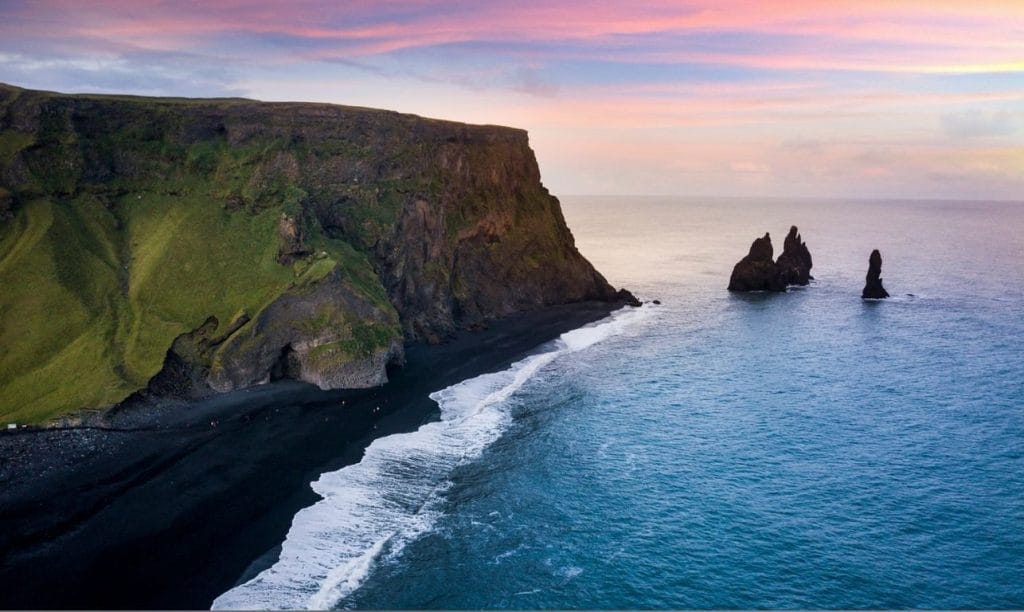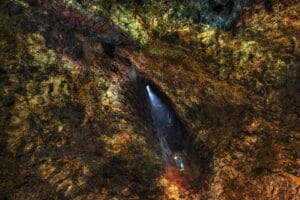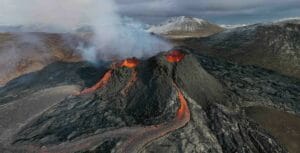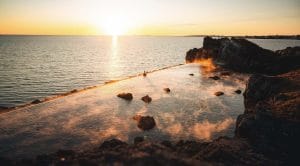Amidst the colorful highlands, mighty white glaciers, foamy grey glacial rivers, glimmering northern lights, and golden hours of the midnight sun, the black sand beaches of Iceland sure come off as a rather surprising contrast to the whole landscape of the country. A place famous for its vibrant landscapes and sights, Iceland never ceases to take the visitors by surprise and present them with something they would never think of finding. Needless to say, black sand beaches are one of these ‘unique things’ that Iceland takes pride in as its hidden gems and for all good reasons too. Mesmerizing and a power-packed sight, the black sand beaches of Iceland seem like a whole new world on their own and give rise to a sensation that people are not familiar with already. In a nutshell, at least one of the many beautiful black sand beaches of Iceland should be on your bucket list of travel spots for the country.

A Unique Entity
While black sand beaches are found across the world in many places, the ones in Iceland hold a special place. What makes the black sand beaches of Iceland different than others is the climatic conditions of the places and other elements of the landscape that comes along in harmony with the aura of the beaches and create a magnificent view for the viewers. The conventional image of beaches with palm trees and the sun shining on the top of the head with a light breeze and hot tropical climate is completely reversed in Iceland and it is nothing but delightful. The beaches in Iceland tend to get extra cold, even colder than the weather usually in Iceland. The cold weather also comes with some challenges which mean that beaches in Iceland can get more dangerous than beaches generally are which adds a new element of thrill to the picture. Unique and one of a kind, the black sand beaches of Iceland are one of the main tourist attractions in the country hiding many other surprises within them, and all for good reasons too.

Black Sand Beaches – Formation
The formation process of normal beige-colored sand takes millions of years itself. The rocks decompose, break down, and erode forming sand in the process. the decaying process of rocks takes a lot of time which means that the sand that we see on beaches is older than all the buildings in the world and maybe even a lot of trees. The process of getting the sand to the beaches is even longer and takes a lot more time as it travels down the streams and rivers.
The beige color of the sand is caused due to the presence of iron oxide which provides a tint of light brown to the quartz rocks and gives origin to a mineral named feldspar which is tan-brown in color. This gives the sand the common beige color that we see.
Although the formation process is quite the same, black sand found on black sand beaches is formed when volcanic rocks erode instead of quartz. These rocks are generously found in areas with high volcanic and geothermal activities like Hawaii, Canary Islands, and yes, Iceland. Basalt is the most common rock that forms black sand along with andesite and volcanic glass. Unlike the generic beige-colored sand, black sand is heavier and is more iron-rick which means that it gets hot very quickly in the summer season and colder in winters. Some of these black sand beaches may also have a few colored elements like small stones and rocks which are influenced by weathering. These rocks include light-colored quartz, olivine crystals, and carbonate biogenic grains.
Black sand beaches can be of at least 2 types with further subdivisions on hand. Beaches found in Iceland are the ones generally formed with eroded basalt rocks that have been crushed into fine sand particles by the water forces of their carrier rivers and streams.
Black Sand Beaches of Iceland
There are several beaches in Iceland, and most of them qualify as the iconic black sand beaches of the country. With each of them flaunting their specific qualities and traits, one must be aware of all the options at hand in order to pick one for their visit to the land of ice and fire. Let us explore them one by one.
Reynisfjara Black Sand Beach

The most popular beach in Iceland, the Reynisfjara black sand beach is all that you need to witness on your trip to the land of ice and fire if you are short on time but want to experience the best of black sand beaches of Iceland. Very conveniently accessible, the Reynisfjara black sand beach is one of the most beautiful places in Iceland. The panoramas of Reynisfjara beaches are on a whole other level with stunning basalt columns on one side, beautiful foamy white crashing waves on the other, and puffins soaring around the nearby Dyrhólaey rock arch and cliffs. It was voted one of the top 10 beaches to visit on the planet by National Geographic in 1991 which clearly states its place as one of the top contenders on the list of top list places to visit in Iceland.
This beautiful black sand beach is not only popular for its gorgeousness but also for the various folklore that comes attached to it and the surrounding sites. For example, it is a popular belief that Reynisdrangar basalt columns on the shore of the beach used to be trolls and giants who turned to stone when sunlight touched their skin as they went out late in the night and couldn’t come back before the dawn. Another legend dictates that the basalt columns are two trolls that were frozen by a man as they had murdered his wife. He chased them to the Reynisdrangar cliffs and froze them there so that they can never kill anyone else.
The mesmerizing beauty of the basalt stacks got them a featured appearance in season 7 of the popular HBO series, Game of Thrones. Quite a few scenes to represent the north of the wall were shot here on this black sand beach. Another thing that makes this particular place special is the sheer number of puffins and other migratory birds found nesting and resting on the basalt columns. These birds completely change the aura of this beautiful monochromatic beach and make it into something much livelier than any other tourist spot that you may visit – a true haven for nature and bird lovers.
Reynisfjara beach is located on the southern coast of the country near the Vik village – the southernmost settlement of the country. It is fairly easy to access the beach and the surrounding sites as well. Whether you are taking a tour of the ring road or paying a visit to the Jökulsárlón glacier lagoon, the Reynisfjara beach can easily be visited without having to make any substantial detours. When traveling to Reynisfjara from the capital city, you will come across many other attractions like Seljalandsfoss and Skógafoss waterfalls, Eyjafjallajökull and Mýrdalsjökull glaciers.
Stokksnes – An Unearthly Beauty

Another wonder located in southern Iceland, slightly towards the east, Stokksnes black sand beach presents you with a view that looks like straight out of somewhere outside of the planet earthly. This heavenly beauty and stark contrasting landscape of the black sand beach is what makes this beach extra special and beautiful. However, not as many tourists visit this place as other sports in the country and are frequented by photographers mostly for the gorgeous views and opportunities that it provides.
Along with being one of the top locations preferred by professional photographers to get some great shots, Stokksnes black sand beach, and its surrounding mountain range also have a rather rich and interesting history. The whole Stokksnes peninsula used to be an important front for the British army during World War 2 and is also one of the first places where the Vikings settled in.
The beach itself has many different geological elements for nature lovers to explore. Along with the signature black sand derived from the ash and eroded particles from nearby volcanoes, here you will find dispersed volcanic rocks, dried-up vegetation, and gorgeous long-stretched lava plains. Not only that, Stokksnes black sand beach comes with an added bonus of Vatnajökull glacier, Jökulsárlón glacier lagoon, and the mighty Vestrahorn mountain range which means that you can easily fit a trip to this beach in your extensive plan to visit the wonders on the south coast of the country.
Diamond Beach of Iceland

The South Coast of Iceland hits another jackpot with this beach featuring an out-of-the-world beauty. The Diamond Beach of Iceland is probably the only one of its kind which makes it an important thing that you visit this wonder when on the tour of the south coast of Iceland. The diamond beach is located near the Jökulsárlón glacier lagoon. The icebergs floating the lagoon have broken down from the nearby glacial tongue Breidamerkursandur which is one of the 30 outlets of the Vatnajökull glacier. The icebergs breakdown from this glacial tongue and reaches the outwash plain which was formed when the three surrounding glacial tongues started flowing forward because of volcanic activity. Then they get transferred to the Jökulsárlón glacial lagoon. The icebergs float in the lagoon and then enter the Atlantic Ocean. The icebergs get carved by the waves for a long and take on a transparent shape like that of crystals or diamonds. These carved icebergs then wash up on the shore and hence give birth to the diamond beach.
If you are planning to take some fantastic pictures during your stay in Iceland then diamond beach should be a must-visit in your list of potential picturesque locations. The black sand on the shore combined with crashing foamy white waves and the huge ice crystals scattered all over the black sand makes the mood for amazing dramatic monochrome photographs. While you are at it, also take some time out to visit the surrounding glacier, go for a hike or get kayaking in the many different lagoons at the foot of these glaciers. The experience will become a complete one-day trip package for you.
Héraðssandar
Quite a different view from other black sand beaches that you would find in Iceland, Héraðssandar black sand beach is one of the more subtle and silent kinds of places in Iceland. It is located in the eastern part of the country near road number 94 if driving from the south or near road number 917 if you are coming from the north. This beach has black sand spread over a few meters and the rest of the plain in the valley is covered by lush green vegetation, small streams, and carefully carved paths, one of which is a mountain pass leading to Vopnafjörður.
Although getting to Héraðssandar black sand beach is majorly dependent on weather conditions. If there is a chance of having bad weather on a certain day, it is advisable to either visit another day or take a few extra precautions in order to be safe and secure when on the beach. When visiting this black sand beach, consider taking some time out to travel down the mountain pass and visit Vopnafjörður as well.
Fauskasandur

Fauskasandur black sand beach is one such lesser-known place that is still hidden from most of the population. Situated in the eastern part of the island, this is the perfect place to stop for when you are on a self-driving tour of the eastern part of Iceland. It is best known for a huge rock that stands amidst the ocean near the beach. This monolith is quite captivating with a green top and black colored demeanor that it holds. The contrast that the rock and the dark black sand creates with the white foamy waves of the ocean is simply mind-blowing enough for you to drop everything and spend a few moments of calm in this place. The black basalt rocks on the side, ocean on the other, and the monolith along with the beautiful glimmering sand in the middle are as mystical as the mountains of the east.
Very Easily Accessible
Beauty and charisma aside, one of the best things about Iceland’s black sand beaches is that they are very easily accessible to most tourists that too all-year-round. Most of the exceptional locations in Iceland are hard to come by either due to the weather limitations or the condition of the paths. But you can easily get to any black sand beach in Iceland in a car, 2×2 or 4×4, and on foot as well, depending on the distance. On that note, one must take care of the fact that driving off-road in Iceland is not permitted and is punishable by a fine. So, beaches must always be traveled on foot but you can certainly use your car to get to the vicinity.
The fun thing is that no matter which part of the country you are traveling to, there will always be a black sand beach well within your reach. Whether you are in the capital cruising around the outskirts, chasing the puffins on the south coast, or heading north for some less-visited wonders, the black sand beaches of Iceland are located conveniently so that at least one falls on these routes.
A Delight in Every Season
There is no bad season to visit beaches in Iceland, unlike most places where beaches are preferred as a vacation spot in warm weather. Iceland is relatively colder as compared to other places famous for its beaches which means that no matter when you visit an Icelandic black sand beach, the glory will be exactly the same. Moreover, imagine feasting your eyes on crashing white waves on a black beach covered in snow, magical right? That is probably what you will get to see if you visit these beaches in the winter season making it totally worth facing the cold sea breeze. Not only that, the snow on the beach adds a new dramatic angle to your vacation pictures and there will barely be anyone else who can boast something like that.

A Word of Caution
There is no harm in letting yourself go and enjoying the moment once you get to the location but precautions should always be taken in order to make sure that safety is never compromised. Iceland’s black sand beaches are one of these places where safety measures should always be taken care of before you start relaxing. Depending on the weather, these beaches can pose several dangerous situations so, we have prepared a list of things you should consider taking care of beforehand.
Be Vary of the Sneaker Waves: You will never know when a huge wave will sneak up on you, hidden behind a small, not-so-dangerous-looking one. Always be vary of sneaker waves when you are at the beach or too close to the water. Check the weather forecast and try to stay far back from the surf break of the beach. It is plausible that you would want to get closer to the water to get some solid selfies but it is better to keep safety above selfies, no matter how beautiful the location seems to be. Extra caution should be taken when visiting beaches of the south coast as sneakers waves are the deal there and a long persisting problem too.
Tally the Weather: Beach or not, always check the weather forecast before you set out on your journey. While it is true that the weather may change at the point in time in Iceland, without much warning, it is still smart to be prepared from your end. Black beaches of Iceland tend to get extra rumbunctious when the weather is bad with wind traveling at a speed of 75mph so, it is a good idea to postpone the plan if the weather does not seem to be on the good end of the bargain. Change plans and shift things around.
Always Wear Appropriate Clothing: Proper clothing should never be compromised when traveling in Iceland. Layer up to avoid problems when you are outside with no chance of changing clothes if you feel like it. Instead of wearing one super heavy jacket on a single sweater or t-shirt, wear at least 3 layers of clothes – base layer, warm sweater or hoodie or jacket, a heavy jacket like puffer jacket with fleece lining or something equally warm and also consider wearing water and a final layer of wind and waterproof clothing. Proper hiking shoes are also recommended along with gloves and hats if the weather is windy or colder than usual.




















































